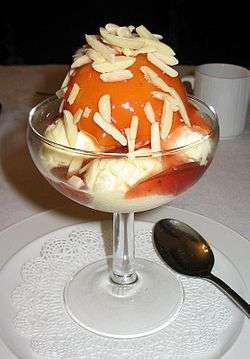Peach Melba
Peach Melba (French: pêche Melba, pronounced [pɛʃ mɛl.ba]) is a dessert of peaches and raspberry sauce with vanilla ice cream. It was invented in 1892 or 1893 by the French chef Auguste Escoffier at the Savoy Hotel, London, to honour the Australian soprano Nellie Melba.[1][2]
 | |
| Type | Dessert |
|---|---|
| Created by | Auguste Escoffier |
| Main ingredients | Peaches, raspberry sauce, vanilla ice cream |
Creation of the dessert
In 1892, operatic soprano Nellie Melba was performing in Wagner's opera Lohengrin at Covent Garden. The Duke of Orléans gave a dinner party to celebrate her triumph. For the occasion, Escoffier created a new dessert, and to display it, he used an ice sculpture of a swan, which is featured in the opera.[2] The swan carried peaches which rested on a bed of vanilla ice cream and which were topped with spun sugar.
In 1900, Escoffier created a new version of the dessert. For the occasion of the opening of the Carlton Hotel, where he was head chef, after he had been quietly sacked from the Savoy for embezzlement along with the CEO, Escoffier omitted the ice swan and topped the peaches with raspberry purée.
Variations
Other versions substitute pears, apricots, or strawberries instead of peaches or use raspberry sauce or melted redcurrant jelly instead of raspberry purée.[1] The original dessert used simple ingredients of "tender and very ripe peaches, vanilla ice cream, and a purée of sugared raspberry". Escoffier himself is quoted as saying, "Any variation on this recipe ruins the delicate balance of its taste."[2][3]
Pijama
Peach Melba is claimed to be the ancestor of the pijama, a dessert in Catalan cuisine. 7 Portes, a famous restaurant in Barcelona founded in 1836, is credited with its creation in 1951, when officers of the U.S. Sixth Fleet stationed in the nearby harbor would often dine at 7 Portes and order Peach Melba for dessert. The name mutated to pijama ([pi.ˈʒa.mə], Catalan for pajamas) among the Catalan-speaking kitchen staff. From there the recipe, or the essence of it, spread throughout Catalonia.[4] Variations are countless, but ice cream, flan, and fruit in syrup (peach and/or pineapple) are its staple ingredients.[5]
Though regarded as an extravagant and somewhat outdated dish today, the pijama was considered part of the corpus of the Catalan cuisine and its recipe was included in the inventory published by the Foundation of the Catalan Institute of Cuisine and Gastronomical Culture.[5][6]
Cultural significance
In tribute to Escoffier an elaborate deconstruction of the peach Melba was served as the last dish at elBulli prior to its closure in 2012.[7][8]
References
- Prosper Montagne, ed. (2001-10-02). "Melba". Larousse Gastronomique (Rev. Sub. ed.). New York City, New York: Clarkson Potter. p. 733. ISBN 978-0609609712.
- Avey, Tori. "Opera, Escoffier, and Peaches: The Story Behind the Peach Melba", August 22, 2012, accessed 9 April 2015
- "Peach Melba - The Auguste Escoffier Way" (PDF). Melba Magazine. Tasmanian Symphony Orchestra: 4. 2017.
- Morán, Iker. "El restaurante que inventó el mítico postre 'Pijama'". 20 Minutos (in Spanish). Retrieved 2019-09-11.
- "Pijama". Catalunya Cuina (in Catalan). Retrieved 2019-09-11.
- Corpus del Patrimoni Culinari Català (in Catalan). Barcelona: La Magrana. 2009. p. 339. ISBN 978-8482648156.
- "A última valsa do elBulli". Menu. Retrieved 2015-02-03.
- M. Pilar Opazo (2016-07-05). Appetite for Innovation: Creativity and Change at elBulli. New York: Columbia University Press. p. 17. ISBN 978-0231176781.